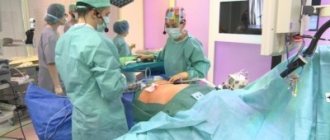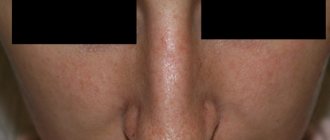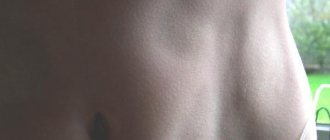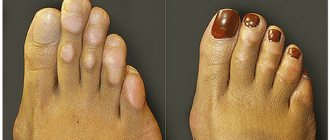Photos "Before" and "After"
See more “Before” and “After” photos
What should a beautiful belly look like?
- elastic, elastic anterior abdominal wall
- pronounced lateral and groin area - what we call the waist
- soft contours: the anterior abdominal wall is concave in the upper part, slightly convex in the lower part
- moderately pronounced muscles
- The diameter of the navel is 1.5 - 2 cm. In a vertical position, it should be in the middle between the pubic bone and the xiphoid process; in a horizontal position, the median of the navel should be located between the upper axes of the iliac bones.
Excess weight and pregnancy are two main factors that negatively affect the aesthetics of the body. In some cases, sports and diets only partially solve the problem. A stretched skin-fat apron cannot be removed either by exercise or by proper nutrition.
⇒
How does a consultation with a plastic surgeon proceed? What are the stages of the operation itself?
The main task of doctors during a consultation is to assess the real need for abdominoplasty in a particular patient and identify possible contraindications. During the conversation, the specialist will discuss with you all the details of the upcoming intervention, including the need and volume of liposuction.
On the day of surgery, as a rule, the patient is photographed to visually assess the results of abdominoplasty.
Abdominoplasty is performed under general anesthesia. First, liposuction is performed, then incisions are made along pre-marked lines on the abdomen. After this, the muscles of the anterior abdominal wall are sutured and their discrepancies are eliminated - this is the key to getting a flat stomach. This is followed by removal of excess subcutaneous fat (usually in the form of a single flap), relocation and fixation of the navel in its natural position. The operation ends with suturing and bandaging. The total duration of the intervention, depending on its volume, ranges from 1 to 4 hours.
When is abdominoplasty indicated?
Let's figure out when surgery is the only way to return the body to the desired contour:
- skin-fat apron after childbirth or significant weight loss. The skin-fat apron represents large volumes of stretched, lost elasticity of the skin and excessive fat deposits. All this, as a rule, hangs unaesthetically over the bikini area.
- presence of diastasis. Diastasis is the separation of the rectus muscles. Most often occurs after childbirth. The abdominal cavity protrudes at the bottom. It occurs to varying degrees in almost all women after childbirth. If the muscles diverge by a distance of more than 3 cm, abdominoplasty is indicated.
- unaesthetic scars after cesarean section
- excess fatty tissue that cannot be eliminated by conservative methods for a long time
- contraindications to abdominal training
Abdominoplasty is more of an aesthetic surgery. Body plastic surgery is done primarily to improve the quality of life: to wear fashionable clothes, get rid of possible complexes about your figure, and improve your sex life. Abdominoplasty is a fairly serious surgical procedure. An anterior abdominal wall lift is in demand among women aged 20–45 years who have recently undergone pregnancy.
Direct clinical indications for surgery are diastasis, hernia and persistent diaper rash in the folds of the abdomen, which leads to dermatological diseases and sagging skin.
⇒ WE ALSO ADVISE YOU TO READ: Abdominoplasty or liposuction: what exactly do you need?
Are there any contraindications for abdominoplasty?
Yes, there is, as for any other surgical intervention. First of all this:
- decompensated heart and/or pulmonary failure;
- severe diabetes mellitus;
- high degree of obesity;
- active infectious or inflammatory process in the body;
- a number of serious chronic pathologies.
In cases of severe obesity, abdominoplasty is not performed due to the high likelihood of complications. In addition, if the patient quickly loses weight after surgery, there is a high risk of excess skin forming again. Therefore, plastic surgeons recommend performing interventions after losing weight.
Big belly and obesity are contraindications for surgery
Out of ten people who apply for weight loss, only two will become my patients . Why do I refuse the majority?
The fact is that for many, an increase in abdominal volume is directly related to the problem of obesity and the presence of excess visceral fat. Visceral fat is localized in the abdominal cavity and surrounds the internal organs. A protruding belly is the result of the growth of both visceral and subcutaneous fat.
During abdominal tummy tuck we work only with the subcutaneous layer of fat, which does not solve the patient’s problem.
⇒
What does the navel look like after surgery?
The appearance of this part of the body greatly depends on a number of indicators. Of course, the main influencing factor remains the type of plastic surgery. If, for example, mini-abdominoplasty was performed, then the umbilical area in this case will remain unaffected, and the appearance of this part will not change. Also, the appearance, shape and location will not change even if the volume of tissue removed is small.
The goal of abdominoplasty is beauty and symmetry in everything.
With classic abdominoplasty, as well as with umbilicoplasty, work with the navel is inevitable. Therefore, the doctor’s task is to give it the proper position, shape and size. Placement must be strictly in the middle. The shape is usually funnel-shaped, with smooth edges. The main criterion that the surgeon adheres to is the symmetry of both location and shape.
My approach and methods
The methods and tools of modern aesthetic surgery allow the specialist to achieve the most perfect and natural contours. Harmonization is the main trend in the aesthetic direction of medicine. This applies to all areas that the surgeon corrects. The abdominal area is no exception. In my practice, I use the following set of surgical tactics to create an attractive area between the breasts and hips.
Classic abdominoplasty
This is the most common tummy tuck option. An incision is made in the area above the pubis from one hip to the other and around the navel. The skin and subcutaneous fat tissue of the anterior surface of the abdominal wall are mobilized and, if necessary, diastasis of the rectus muscles is sutured. Next, the navel is transferred to a new location, excess skin and fat are removed and a cosmetic suture is applied.
Abdominoplasty with suturing of diastasis and navel transfer is the most popular figure correction operation. This is due to the fact that radical measures, which include classic abdominal surgery, are resorted to by women tired of the burden of stretched skin. Older people do not always suffer from a big belly. Often young women 30-40 years old after their second and subsequent pregnancies have such an aesthetic defect.
During the intervention, the surgeon removes excess skin. Liposuction is used to remove fat deposits. In 99% of cases, these two operations complement each other, that is, they are performed together.
⇒
Complications after abdominoplasty:
Any surgical intervention is associated with a certain risk of complications. Their development can be significantly reduced by carefully following the doctor’s recommendations in the pre- and postoperative period. Particular consideration should be given to the need to perform surgery in patients with concomitant diseases and smokers, as this is associated with an increased risk of complications. However, some of the possible complications are genetic and highly individual. Therefore, a qualified plastic surgeon will always tell you about the possible consequences during the preliminary consultation.
Among the complications of the early postoperative period, the appearance of hematomas and seromas is possible. To prevent them, drainage tubes are installed during abdominoplasty. In some cases, residual serous fluid can later be removed by puncture with a syringe through the skin. Wearing compression garments prevents the formation of seromas.
Excess scarring may develop at the incision site when the patient tends to develop hypertrophic or keloid scars. To prevent excessive scarring in the postoperative period after removal of sutures, it is necessary to rub in anti-scarring medications that the doctor will recommend to you.
How is tummy tuck performed?
Abdominoplasty is performed in several stages:
Preparation for the procedure
Tummy tuck is a large-scale and serious procedure. Preparation consists of two stages:
- lifestyle correction: I ask smokers, if possible, to give up the bad habit or reduce nicotine consumption to a minimum. Smoking negatively affects tissue healing.
- full medical examination: 14 days before surgery, according to the prescribed list, the patient undergoes laboratory tests and visits specialists to exclude contraindications.
List of tests
- Clinical blood test
- Biochemical blood test (total protein, urea, creatinine, bilirubin (total), ALT, AST, glucose, potassium, sodium)
- Coagulogram (INR, prothrombin, bleeding time, clotting time)
- Blood test for RW (syphilis), HIV
- Hbc
- antigen + anti HCV (hepatitis B, C)
- Blood group, Rh factor
- General urine analysis
- ECG (electrocardiogram) with interpretation
⇒
Side effects
As with any surgery, there are side effects following abdominoplasty that you need to be prepared for and be aware of.
Edema
Since the operation involves removing excess skin, fat deposits and suturing the abdominal muscles, the lymphatic channels and blood vessels will certainly be damaged. Because of this, swelling occurs.
How to remove swelling and when will it go away? There is no way to remove it. The main swelling will go away in a few weeks , and minor remnants will disappear after another three months.
When do the bruises go away?
Bruises occur for the same reason and go away on their own. This will take from 10 to 14 days.
Temperature
An increase in temperature is a normal reaction of the body to damage to its integrity, which is observed after any surgical intervention. It goes away on its own a few days after surgery.
Pain
This is also quite normal. The pain syndrome can last for several months . You can get rid of unpleasant sensations with the help of painkillers.
Unsuccessful plastic surgery
Most often, unsuccessful tummy tuck occurs in those patients who had serious contraindications to it, but they still had the operation. Such neglect almost always leads to severe complications.
Another unsuccessful operation can happen due to an inexperienced surgeon. Or with significant removal of fatty tissue.
The consequences of a poorly performed operation are a shift of the navel and a very pronounced suture. There are cases when plastic surgery was done too early, and after it the patient loses weight, as a result, tissue sagging occurs.
In case of unsuccessful tummy tuck, a repeat operation is prescribed.
First days
Prepare for discomfort in the first days! You will experience pain whenever you move your body. The stomach will become hard. Therefore, I prescribe pain medication and maximum physical rest.
Unpleasant sensations are caused by the combination of skin tension in the abdominal wall, sutures and tight compression garments. During sleep, the legs are slightly elevated to reduce tension.
On the second day, the patient begins to stand up and walk independently. The correct pose is in a half-bent position (“shrimp pose”).
At the 4-5th post-tummy tuck, the patient feels significant relief.
How long does the swelling last?
Swelling and bruising are a natural consequence of recovery after correction. Swelling persists for up to several months. To eliminate this, I recommend sleeping on your back, drinking a small amount of water and doing a light massage of the anterior abdominal wall to improve blood circulation.
Are stitches visible after abdominoplasty?
Abdominoplasty without skin tightening leaves virtually no marks. The cannula is inserted through very small punctures.
After classic plastic surgery, the seam is quite large (from hip to hip), but is very low along the bikini line.
After mini-abdominoplasty, the seam is small and, as a rule, is also localized in the place of camouflage with underwear.
Caring for sutures is an important aspect of rehabilitation. At first, you will need to change the bandages daily. You cannot get it wet, stretch it, or try to get rid of surgical sutures on your own.
Remember that suture healing is a long process (up to 1 year). A year after plastic surgery, the seam will lighten and become much less noticeable.
How to care during the recovery period
After surgery, the patient is put on compression garments. Underwear must be worn for a set period of time (usually no more than a month), during which it cannot be removed or moved. As you recover, you can get rid of your underwear during hygiene procedures or sleep at night, but not earlier than the surgeon allows.
It is necessary to follow the general rules and prohibitions - refrain from sports, heat treatments and ultraviolet rays, sleep on your side with your legs tucked in, and also treat injured areas.
You should carefully monitor your condition and consult a doctor promptly. For example, if your belly button gets wet after abdominoplasty, this may be caused by damage to the blood supply and death of the upper layers of skin. In this case, if you follow the rules of care, the area will recover itself over time. But if suppuration is observed, this is already a reason to visit a doctor.
Five months
5 months have passed, I can say that during this time I have fully recovered from the opiate. My life is in the same rhythm, only I have become much happier, it’s nice to see my reflection in the mirror. I don’t apply anything to the scar, it is formed as it should be for this period, a little pink, periodically pale. The navel also became smaller as the swelling went down. Our summer is cold, and we are not planning to go to the sea this year, so the problems with tanning have disappeared on their own. I will walk my belly next year, just as the scar will form and all restrictions will be lifted. Seams under clothing, in underwear and under underwear:
How to avoid complications?
To avoid complications, you must follow and implement all the doctor’s recommendations and instructions during the rehabilitation period. During the first day after plastic surgery, the patient is in the hospital, and then goes home, where he recovers independently. In doing so, he must observe the following:
- Treat sutures and change bandages.
- Wear compression garments for a month.
- Move despite the discomfort and discomfort.
- Avoid water procedures until the sutures are removed. You are only allowed to wipe with a towel.
- Do not visit solariums, swimming pools, baths and saunas.
- Avoid intense workouts.
- Do not lift or carry heavy objects.
- Follow the diet prescribed by your doctor. Don't overeat.
- Women must avoid pregnancy for 3 years.
- Do not take any medications, ointments, on the advice of friends. Only those prescribed by the doctor are allowed.
- If complications occur, do not self-medicate.
- You cannot pick off the crusts that have formed on the scar.











